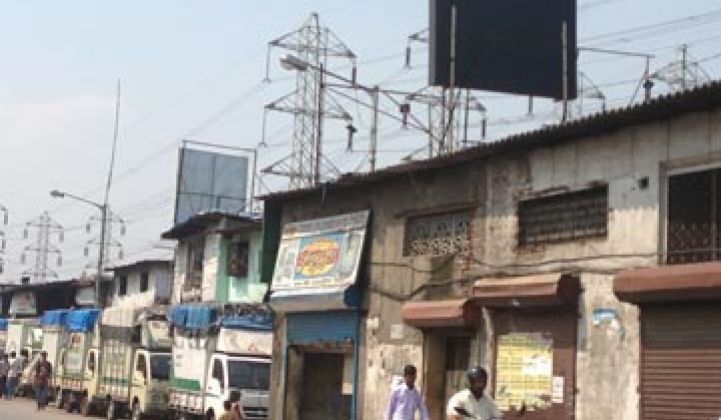It is no secret that the crux of India’s power problems lies in supply shortages.
Power plants, many of them aging and many of them fueled by coal, cannot keep up with the country's upwardly mobile population. Even with soaring demand for air conditioning and televisions, nearly a third of the country’s 1.2-billion-strong population lives without power.
“India is at a crossroads,” said Rupendra Bhatnagar, head of industry business solutions for SAP India, which recently hosted an international team of journalists to show various opportunities -- and challenges -- unfolding across the subcontinent.
The power supply will need to quadruple by 2030 to more than 800,000 megawatts to support the increasing needs of businesses and homes. But simply building more energy supply is not the answer. India suffers from crippling losses, both technical and non-technical (read: theft). The national average for losses is close to 30 percent -- although it can be as high as 50 percent, with even some of the better utilities still over 15 percent. The U.S., by comparison, is at about 7 percent.
The problem of loss is exacerbated by the fact that no one even knows how the patterns of loss break down. In India, the term is "aggregate technical and commercial losses," or ATC. The utilities are not required to report detailed loss percentages, and everything -- from transmission and distribution loss to old-fashioned stealing -- is lumped together into the ATC figure. Information technology that would allow the utilities to measure loss, to better be able to manage it, seems like a logical starting point. Unlike other economies that are using smart grid technologies like volt/VAR optimization to increase distribution efficiency, India just needs any visibility before it moves forward.
But as with many other facets of a booming Indian society, regulators and services are simply treading water. “We’re also facing a problem of transformer overloads,” said Uttam Mane, chief general manager of IT for Maharashtra State Electricity Distribution Company (MSEDCL), which serves nearly 20 million customers in Maharashtra state. In many areas of the utility’s area, there is 16 hours a day of load shed. There is a mandate to have zero load shedding by December 2012 -- a potentially impossible task.
Software and smart grid technologies could pitch in to reduce the need for regular blackouts, however. A more granular view of what is happening on the grid is sorely needed. MSEDCL is installing meters at the transformer level to be able to better measure losses down the line. Demand response does not exist in India, but it is on the agenda of the India Smart Grid Forum.
“There’s talk in the ministry of power to bring in some of these technologies to make the grid more reliable,” said Bhatnagar, a conversation that has likely accelerated after the massive blackout in August.
For utilities, the technologies will likely be items that most western utilities take for granted – like SCADA systems and upgraded customer platforms. MSEDCL, for instance, placed an order for a SCADA system with Siemens earlier this year. Some IT companies, like homegrown giant Infosys, are already working on solutions to help utilities collect money more efficiently. Infosys has launched a “customer self-service” product for utilities to link billing platforms and customer management to mobile applications.
But true smart grids, with two-way, digital smart meters and intelligence on the grid, are not even on the horizon for most utilities. “If you have no electricity, [smart grid] is the furthest thing,” said Rahul Tongia, Independent Consultant and Advisor to Ministry of Power for Smart Grid Pilot Projects. “A rooftop solar panel is not what most Indians are clamoring for.”
But Indians, who often keep diesel generators handy for use during the country's regular blackouts, could be prime customers to respond to pricing signals. “They already arrange their life around electricity,” said Tongia. “Saving $1 is a big deal to an Indian.” He noted that any new meters being installed across the country are digital and upgradeable. “[What] utilities are working on is what capabilities they want to plan for, even if they don’t want to turn it all on.”
Unlike China, which is investing heavily in smart grid and upgraded infrastructure to meet the needs of its expanding economy, India has 78 different utilities, where as China’s State Grid Corporation controls more than 80 percent of the country’s electricity supply. India is also a democracy where decisions are less likely to be formulated then handed down from a more authoritative government.
In many ways, India has some of the same challenges as the U.S. Even though reliability is far higher in America, there are many utilities in both countries instead of a few state-owned entities. Regulations can barely keep up with the changing needs of the power sectors and are often not robust enough to encourage the investment and change needed. There is barely any real retail competition, according to Tongia, although generation and distribution has been decoupled in many states.
Even though smart grid technologies cannot solve, or even put a dent in, India’s power problems, it will be one part of the solution. An even more appealing market is energy efficiency, which would cost far less. Microgrids are also being tossed around as a solution for remote villages. Renewables will likely be only a small part of the solution in the near term, since India’s peak is in the evening and not during the day. Like the U.S., there are reports that India could dip its toes into offshore wind, although no projects have been announced.
“Everything will be on the table,” said Tongia. “Holistic views are what India will embark on.”



